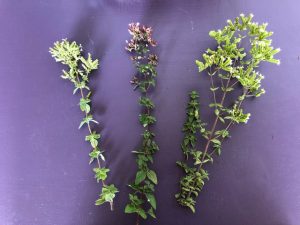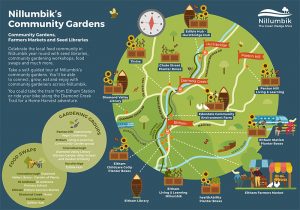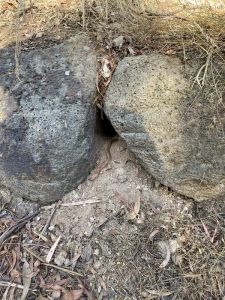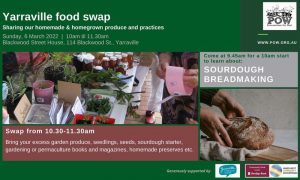Thanks to all the people who have contributed to this week’s newsletter: Beth Ciesielski, Jane MacNeil, Katherine Barling, Laura Nix, Louise Nolan, Megan Goodman, Michelle Casamento, Perri Hillier, Robin Gale-Baker, Sarah Houseman and Sylvia Bianco.
Distinguishing the origanums (by Robin Gale-Baker)
In my experience, gardeners very often find it difficult to distinguish between the different culinary members of the origanum genus. This is not surprising as many plants are mislabelled when sold, the common names can be confusing and there is an array of species with flowers of varying colour, not to mention a range of ornamental plants in the genus. The main culinary plants are:
- Origanum vulgare – oregano (sometimes called wild marjoram or wild oregano), where O.v. subsp. hirtum (Greek or Italian oregano) is the aromatic, culinary subspecies.
- Origanum onites – pot marjoram.
- Origanum majorana – sweet marjoram (sometimes called knotted marjoram).
 In the photo, Oreganum vulgate is on the left, Origanum onites in the middle and Origanum majorana on the right.
In the photo, Oreganum vulgate is on the left, Origanum onites in the middle and Origanum majorana on the right.
It is useful to be able to distinguish one from the other because they range in taste from savoury to sweet, and from hot and spicy to mild or bland.
Origanum vulgare (oregano) is best bought as a plant. It should have lightish green, pointed leaves that are relatively small and have a matt or dull appearance. It is a groundcover but, when flowering occurs, it develops long stems and the leaves which grow up these stems become smaller as they climb toward bracts of white flowers. The taste should be hot and spicy. The reason that this oregano is best bought as a plant is that oregano grown from seed is usually very bland. It has larger leaves that are a mid to dark green and mauve or pinkish flowers. From a culinary perspective, it is disappointing, being almost flavourless. Bought plants, on the other hand, are usually the aromatic hirtum subspecies, which is flavoursome and can be used in savoury dishes.
Origanum onites (pot marjoram) looks very similar to seed-grown oregano. The leaves are larger and spade shaped, dark green with a purple underside. The flowers are pink or mauve and rise out of the groundcover on long stalks at flowering time. This is a milder herb and is ‘thrown into the pot’ to flavour stews, casseroles or whatever is simmering on the stove. It is also used in pizzas and pasta dishes.
Origanum majorana (sweet marjoram) is entirely different in taste to the two above. It has a sweet, musky fragrance. While it is often added to meat dishes in the last few minutes of cooking, it is best used with egg or soft cheese (such as cream cheese). Mashed into the latter, it makes a delicious dip or spread. Origanum majorana grows to a height of about 30cm but, once it flowers, it doubles in height. The leaves are small, velvety and either mid green or grey-green. The flowers look like knots and are white on green knots and not especially attractive. It is because of this knot-like appearance that it is sometimes called ‘knotted marjoram’. It is very attractive to bees.
The origanum genus belongs to the family Lamiaceae, which is commonly known as the mint family. It is native to the Mediterranean region and all three herbs discussed above thrive in hot, dry, mountainous conditions. In fact, the name ‘origanum’ means ‘light of the mountains’. Origanums are perennial in Australia but are treated as annuals in colder climates.
To get the best flavour from these herbs, and in fact any Mediterranean herb, plant in poor soil and under-water rather than over-water. Under-watering allows the essential oils to develop and consequently provides strongly aromatic foliage. Herbs that look lush are to be avoided as lushness comes at the expense of flavour. These herbs are best harvested early in the morning and before watering.
If you want to read more about these and other herbs, I recommend The Encyclopedia of Herbs and Herbalism, edited by Malcolm Stuart and originally published in 1979.
Read Robin's equivalent articles about chamomile and about the tarragons.
Nillumbik’s community gardens
 Nillumbik Council has produced a nice map of the various community gardens in Nillumbik.
Nillumbik Council has produced a nice map of the various community gardens in Nillumbik.
Yet more on allotments versus communal growing for community gardens
Last week, I asked newsletter readers to send in lists of the advantages of allotments. Jane MacNeil, President of Canterbury Community Garden (which is currently out of action due to re-development of the site), has risen to the challenge. Here is her list:
- We can grow whatever we like, for example a whole bed of garlic, a combination of companion plants or just a seasonal range. Some gardeners grow flowers in their plots rather than vegetables.
- Not being an expert, it is good to see the plots of more experienced gardeners and obtain advice and inspiration from their crops.
- There is a clear delineation of responsibility for the upkeep of plots, with the committee approaching anyone whose plot is neglected.
- We still see other gardeners, whether in passing over the weeks or at the regular working bees held to maintain common areas of the garden.
Do you know?
When I include readers’ questions in this newsletter, no one usually answers so I ask again the following week and then usually get lots of answers. So, we get there in the end but we needlessly lose a week, by which time some people have forgotten the original question. How about we turn over a new leaf (sic) and people respond at the first time of asking?!
Rat infestation
 Sarah Houseman writes in: “I have an established native garden and we have a big problem this year with rats using our rockeries as highways and homes (see photo). They show their activity by leaving piles of excavated soil and they are destabilising plant roots. As we walk over the garden, our feet subside. Does anyone know of any ecologically friendly method of dealing with rat infestations?” Can anyone advise Sarah – email your responses.
Sarah Houseman writes in: “I have an established native garden and we have a big problem this year with rats using our rockeries as highways and homes (see photo). They show their activity by leaving piles of excavated soil and they are destabilising plant roots. As we walk over the garden, our feet subside. Does anyone know of any ecologically friendly method of dealing with rat infestations?” Can anyone advise Sarah – email your responses.
Fungal issues
Louise Nolan writes in “For the last few years my veggie garden has been experiencing fungal disease regardless of crop rotation, adequate spacing and watering only the base. All my beds are mulched with pea straw which is topped up as needed. I believe that the initial culprit was a bale of pea straw that was black and grey throughout. There is rust on my fuchsia and geranium, black spot on my peas and beans, anthracnose on my cucurbits, blight on the my tomatoes and powdery mildew on my zucchini and pumpkin. My apple tree also had a disease which looked like a blight. I also had a terrible whitefly infestation, which has now died down with the summer heat. I regularly water with a seaweed liquid and a fish emulsion as required. I have used Neem oil and also resorted to a copper spray for the diseases. The soil pH is neutral, the garden gets morning north sun but is hot in the afternoons with the west sun. I’m at my wits end on how to get on top of it all.” Can anyone advise Louise – email your responses.
Meg’s garden this month
Finally, I have a good tomato harvest and the smell of them roasting with garlic and basil for passata is permeating the house. The plants are now starting to look a bit sad and it won’t be long before the season is finished. The zucchini have been also been bountiful, but white mildew now dusts the leaves and it is time to think about clearing the beds. The draw of plump bags of horse manure on the roadside is strong. This will refresh the slightly water-repellent soil and, if placed now, there will be time to smother weeds before autumn plantings.
The long, sweet, green capsicums and eggplant are hanging and I am waiting for them to ripen. The beans are still growing strongly. I always plant a second sowing in January and they should be ready to harvest by early March. I am growing a new variety this year, namely bush red snake beans (see photo right). The long red beans sprinkle the garden like tchotchke and are growing well, perhaps due to the humid summer.
This month I am:
1. turning compost ready for topping up cleared beds;
2. picking beans, eggplant and capsicum; and
3. watching the apples closely for ripeness in the hope of beating the birds.
Passata
2 kg tomatoes (any variety but roma types are best)
2 teaspoons dried oregano
3-4 cloves garlic or to taste
2 tablespoons olive oil
2 teaspoons honey
2 teaspoons balsamic vinegar
salt and pepper to taste
1 bunch of basil leaves
Place all ingredients in a roasting dish and toss together. Cook in the oven at 180degC for around 30 minutes. Cool slightly and process in a moulie until fine sauce.
If you don’t have a moulie, you can blanch and skin the tomatoes prior to roasting or, alternatively, just remove as much skin as you can post roasting and process in a food processor.
I store my passata in the freezer, but you can bottle and preserve.
Not local but interesting
 Beth Ciesielski has written in to say that a new food swap is starting in Yarraville. The first pilot session will be on Sunday, 6th March, 10-11.30am (see flyer right). If all goes well, it will then happen on the first Sunday of every month.
Beth Ciesielski has written in to say that a new food swap is starting in Yarraville. The first pilot session will be on Sunday, 6th March, 10-11.30am (see flyer right). If all goes well, it will then happen on the first Sunday of every month.
Not food-related but interesting
The Nillumbik Repair Cafe now happens every month, on the 2nd Saturday, 9.30am-12.30pm at Hurstbridge Community Hub, 50 Graysharps Road, Hurstbridge. You sit with the repairer, who is a volunteer, while they talk you through what they’re doing and (hopefully) fix your equipment.
Which link was clicked most times in the last newsletter?
The most popular link in the last newsletter was the video of founder Shanaka Fernando making the announcement that all three Lentil as Anything pay-what-you-feel restaurants are closing.
 Joke (or pun) of the week
Joke (or pun) of the week
Growing your own tomatoes is the best way to devote 3 months of your life to saving $2.17.
Regular activities over the coming week
Farmers’ markets
- Saturday: Abbotsford and Coburg.
- Sunday: Alphington, Carlton, Eltham and Heathmont.
Food swaps
- Saturday: Bayswater North, Brunswick East, Fitzroy, Heidelberg West, Pascoe Vale, Rosanna and Warrandyte.
- Sunday: Montmorency (also The Great Tomato Taste Off) and Regent (Reservoir) (also The Big Picnic).
Note that the Montmorency swap has moved to a new venue (The Monty Hub) and, furthermore, that next Sunday’s swap is part of a bigger event (The Great Tomato Taste Off).
Note that next Sunday’s Regent swap is part of a bigger event (The Big Picnic) and is not at its usual location.
Community gardens
- Thursday: Diamond Valley Library (Greensborough) and Edible Hub (Hurstbridge).
- Friday: Bellfield, Reynard Street (Coburg) and West Brunswick.
- Saturday: Links (Lalor), Macleod and Thrive (Diamond Creek).
- Sunday: Pentridge.
- Monday: Whittlesea.
- Tuesday: Watsonia Library and Diamond Valley Library (Greensborough).
- Next Wednesday: Macleod, Newton Street (Reservoir) and Span (Thornbury).
Upcoming face-to-face events – not cooking
Curry punk & jelly brain – exploring the weird world of fungi; Friday, 4th March, 11am-midday; free; Doncaster.
In this illustrated and interactive seminar, ecologist, photographer and author Alison Pouliot will explore the lives of fungi. Signed copies of Alison’s book, The Allure of Fungi and Wild Mushrooming, will be available for purchase.
Summer/Autumn fruit tree pruning; Saturday, 5th March, 9am-midday; $25 ($8 per hour); Forest Hill.
In Melbourne’s temperate climate, deciduous fruit trees don’t go fully dormant so winter pruning encourages tall whippy growth that will eventually have to be pruned-off. Join Scott Hitchins to learn the ins and outs of Summer/Autumn pruning, plus preferred cuts and trims to produce healthy, bountiful backyard fruit trees.
The Great Tomato Taste Off; Sunday, 6th March, 10am-midday; free; Montmorency.
This annual event gives growers a chance to show off the amazing varieties of tomatoes grown locally. Local growers are invited to bring along their favourite varieties of home-grown tomatoes and put them to a taste test. Both growers and non-growers are invited to taste and compare and to cast a vote for your favourite variety for the People’s Choice Award.
The Big Picnic; Sunday, 6th March, 11am-1pm; free; Reservoir.
 12 local community groups from Reservoir will be getting together and everyone is invited. Take picnic gear, food, produce and plants to share. Meet others in your community and join and support those that are building a stronger connected community.
12 local community groups from Reservoir will be getting together and everyone is invited. Take picnic gear, food, produce and plants to share. Meet others in your community and join and support those that are building a stronger connected community.
Neighbourhood house community garden bus tour; Thursday, 10th March, 9.30am-3.30pm; free; various in Darebin.
Visit 5 neighbourhood houses and check out their community gardens. Note that the itinerary is still to be confirmed.
Autumn in the Heide kitchen garden; Thursday, 10th March, 10.30-11.30am; $27 ($27 per hour); Bulleen.
Heide’s Kitchen Gardener Alice Crowe will explain the methods that she uses to get the best out of the crops grown at Heide, provide tips and techniques, and the delicate biodiversity that helps plants to thrive in autumn.
Heritage apple tasting; Sunday, 13th March, 4-6pm; $15; Templestowe.
Sample the seasonal flavours of the heritage apple collection. Around 15 varieties will be available for tasting. An orchard tour is included. All funds received go toward the maintenance and expansion of the collection. Organised by the Heritage Fruits Society.
Plant your own food; Thursday, 24th March, 4.30-5.30pm; free; Nunawading.
Learning to grow our own food is an invaluable skill at any age. You will learn how to plant seedlings and take home a potted plant to care for and hopefully eat one day!
Healthy productive compost and worms; Sunday, 3rd April, 9.30am-12.30pm; $50 ($17 per hour); Bullen Art & Garden (BAAG).
What you will learn: the importance of compost for soil health; how to fix common composting problems; and setting up and looking after a worm farm. Presented by Kirsteen Macleod. Learn how to make compost, the essential ingredient for a thriving and healthy garden. Look at worm farms and Bokashi as other options. They will also show you how to make a DIY worm farm using recycled products.
Reusable beeswax food wraps; Wednesday, 6th April, 6.30-7.30pm; free; Nunawading.
Learn how to make your own reusable food wraps.
Brain food; Thursday, 7th April, 11am-midday; free; Bulleen.
Lindy Cook, The Nutrition Guru, will discuss which foods can enhance memory and learning. Listen to some practical advice on how to make better healthy food choices.
The joy of backyard chooks; Thursday, 7th April, 6.30-9pm; $50 ($20 per hour); Bullen Art & Garden (BAAG).
What you will learn: how to get started with keeping chickens in a suburban backyard; how to house and protect chooks from predators; and how chooks can be used to improve your garden and soil. You will find out just how easy it is to keep a few hens as pets and as the ultimate garden recyclers, as well as everything you need to know about housing, protecting and feeding them, and lots of practical ideas on how to live harmoniously with them in your garden. Suitable for those who have never kept chooks before.
Working to achieve a sustainable organic community garden; Thursday, 21st April, 2-3pm; free; Lilydale.
Join Benson from Lilydale Community Gardens to hear about achieving a sustainable organic community garden in Lilydale. Learn about Bloom, the wicking bed garden in Lilydale which was installed by the Yarra Ranges Council and is maintained by the Lilydale Community Gardens Group. Also, learn how to grow alfalfa.
Edible weeds walk; 2 occurrences on Saturday, 23rd April, at 10.30am-12.30pm and again at 1.30-3.30pm; $25 ($13 per hour); Brunswick East.
Join Adam Grubb, co-author of The Weed Forager’s Handbook, for a fascinating walk on the wild side, foraging for edible weeds.
Urban wine walk; Saturday, 23rd April, midday-4pm; $80; Richmond.
This is a self-guided wine tasting experience, where you choose the order in which you visit the various venues. The ticket includes 30 complementary tastings, a $10 food voucher, a $25 voucher for wine orders and a tasting glass. The participating venues and winemakers: Richmond Club Hotel with Rob Dolan Wines; The Posty with Pacha Mama Wines; The Blacksmith with Innocent Bystander; Maeve Fox with Brown Brothers; Attria Wine Bar with Mount Macleod; Klae with Paringa Estate; South of the Wall with Good Clean Fun Wines; Caddie with Rob Hall Wines; The Precinct with Alkimi Wines; Corner Hotel with Rising Wines; and Waygood with Smallfry Wines.
Australian Distillers Festival; Saturday, 23rd April, midday-7pm; $75; Abbotsford.
There will be around 50 distilleries from around the country plus live demonstrations, food and music. The ticket includes unlimited tastings plus a tasting glass.
Beekeeping workshop; Saturday, 23rd April, 2.30-5pm; $85 ($34 per hour); Brunswick East.
What you will learn: bee behaviour; the various major items that make up a bee hive and how to construct them; and the major tasks in hive management. There will be live bees and honeycomb to look at. The major topics discussed will be: establishing a hive; understanding the tasks to be carried out in Spring; how to go about robbing and extracting honey; and swarm control. Organised by Bee Sustainable.
In March
- Create your own backyard food forest; Wednesday, 2nd March, 6.30-8pm; free; online.
- Wine Selectors 50 best tasting; Thursday, 3rd March, 6-9pm; $149 ($50 per hour); Richmond.
- How to make beeswax food wraps; Thursday, 3rd March, 6.30-8pm; $60 ($40 per hour); Fitzroy.
- Vegetable seed saving; Thursday, 3rd March, 6.30-8pm; free; Edendale.
- Curry punk & jelly brain – exploring the weird world of fungi; Friday, 4th March, 11am-midday; free; Doncaster.
- Summer/Autumn fruit tree pruning; Saturday, 5th March, 9am-midday; $25 ($8 per hour); Forest Hill.
- About the bees – honey extraction; Saturday, 5th March, 10am-2pm; free (gold coin donation); Kinglake.
- Whittlesea Garden Expo; Saturday, 5th March, 10am-3pm; $10; Whittlesea.
- Grow your own native edibles; Saturday, 5th March, 1-2.30pm; $61 ($41 per hour); Abbotsford.
- Macallan masterclass; Saturday, 5th March, 2-4pm; $170 ($85 per hour); Hawthorn.
- Whittlesea Garden Expo; Sunday, 6th March, 9am-3pm; $10; Whittlesea.
- Tea tasting and tea blending workshop; Sunday, 6th March, 9.30-10.30am; $68 ($68 per hour); Northcote.
- The Great Tomato Taste Off; Sunday, 6th March, 10am-midday; free; Montmorency.
- Tea tasting and tea blending workshop; Sunday, 6th March, 11am-midday; $68 ($68 per hour); Northcote.
- The Big Picnic; Sunday, 6th March, 11am-1pm; free; Reservoir.
- Permaculture rental garden tour; Sunday, 6th March, midday-2pm; $5; Macleod.
- Tea tasting and tea blending workshop; Sunday, 6th March, 12.30-1.30pm; $68 ($68 per hour); Northcote.
- Urban foraging; Sunday, 6th March, 1-4pm; $75 ($25 per hour); Forest Hill.
- Tea tasting and tea blending workshop; Sunday, 6th March, 2-3pm; $68 ($68 per hour); Northcote.
- Neighbourhood house community garden bus tour; Thursday, 10th March, 9.30am-3.30pm; free; various in Darebin.
- Autumn in the Heide kitchen garden; Thursday, 10th March, 10.30-11.30am; $27 ($27 per hour); Bulleen.
- Food photography; Saturday, 12th March, 9.30am-12.30pm; $109 ($36 per hour); Eltham.
- Beginning beekeeping course; Saturday, 12th March, 9am-3.30pm; $245 ($41 per hour); Edendale.
- Sparkling wine masterclass; Saturday, 12th March, 2-5pm; $74 ($25 per hour); Northcote.
- Plant sale at Gunyah garden; Sunday, 13th March, 1-5pm; free; Pascoe Vale South.
- Heritage apple tasting; Sunday, 13th March, 4-6pm; $15; Templestowe.
- Complete urban farmer (14 sessions); weekly, starting Wednesday, 16th March, 9am-3pm; $880 ($10 per hour); CERES.
- Food forest gardening; Thursday, 17th March, 6.30-8pm; free; Edendale.
- Veggie gardening for beginners; Thursday, 17th March, 6.30-9pm; $55 ($22 per hour); Bulleen Art and Garden (BAAG).
- Pest and disease drop-in session; Saturday, 19th March, 10am-midday; free; Hurstbridge.
- Autumn plant sale; Saturday, 19th March, 10am-4pm; free; Eltham.
- The Herb and Chilli Festival; Saturday, 19th March, 10am-5pm; $25; Wandin.
- Bees wax wraps; Saturday, 19th March, 2-4pm; $50 ($25 per hour); Mount Evelyn.
- The Herb and Chilli Festival; Sunday, 20th March, 10am-5pm; $25; Wandin.
- Growing mushrooms at home; Sunday, 20th March, 10am-12.30pm; $95 ($38 per hour); Alphington.
- DIY mushrooms; Sunday, 20th March, 10am-4pm; $165 ($28 per hour); CERES.
- Starting winter veggies from seed; Sunday, 20th March, 11am-1pm; $30 ($15 per hour); Edendale.
- Mushroom cultivation workshop; Sunday, 20th March, 1-4pm; $70 ($23 per hour); Park Orchards.
- Wine appreciation (3 sessions); 3 consecutive Mondays, starting, 21st March, 7-8.30pm; $80 ($18 per hour); Brunswick.
- Plant your own food; Thursday, 24th March, 4.30-5.30pm; free; Nunawading.
- Make a bee hotel; Thursday, 24th March, 6.30-8pm; free; Preston.
- Produce in pots; Saturday, 26th March, 9.30am-midday; $55 ($22 per hour); Bulleen Art and Garden (BAAG).
- Beekeeping workshop; Saturday, 26th March, 2.30-5pm; $85 ($34 per hour); Brunswick East.
- Beginners backyard beekeeping; Sunday, 27th March, 10am-3pm; $220 ($44 per hour); CERES.
In April
- Urban foraging; Friday, 1st April, 10am-1pm; $75 ($25 per hour); Forest Hill.
- About the bees – closing down the bees for winter; Saturday, 2nd April, 9.30am-12.30pm; free (gold coin donation); Kinglake.
- Queensland fruit fly – train the trainer; Saturday, 2nd April, 10am-3pm; free; Hurstbridge.
- Healthy productive compost and worms; Sunday, 3rd April, 9.30am-12.30pm; $50 ($17 per hour); Bullen Art & Garden (BAAG).
- Growing nutrient dense food; Sunday, 3rd April, 10am-3pm; $115 ($23 per hour); CERES.
- Winter vegetable gardening; Sunday, 3rd April, 11am-midday; $5; Watsonia.
- Urban foraging; Sunday, 3rd April, 1-4pm; $75 ($25 per hour); Forest Hill.
- Reusable beeswax food wraps; Wednesday, 6th April, 6.30-7.30pm; free; Nunawading.
- Brain food; Thursday, 7th April, 11am-midday; free; Bulleen.
- The joy of backyard chooks; Thursday, 7th April, 6.30-9pm; $50 ($20 per hour); Bullen Art & Garden (BAAG).
- The art of espalier; Saturday, 9th April, 9.30am-midday; $55 ($22 per hour); Bulleen Art and Garden (BAAG).
- Herb and companion planting; Saturday, 9th April, 10am-3pm; $115 ($23 per hour); CERES.
Regular events
- Bakery Hill whisky distillery tour and tasting; various days and times; $64 ($43 per hour); Bayswater North.
- Flavours of Coburg food tour; various Saturdays, 10am-1pm; $49 ($16 per hour); Coburg.
Upcoming face-to-face events – cooking
Tomato relish; Wednesday, 9th March, 1-2pm; $5; Greensborough.
Sarah will show you how to put your tomatoes to good use. Organised by Greenhills Neighbourhood House.
Cooking up culture with Rita Erlich; Sunday, 27th March, 10.30am-midday; free; Kew.
Experience Jewish culture and watch Rita demonstrate how to make passover cake.
Kombucha workshop; Monday, 4th April, 6.30-8pm; free; Nunawading.
Katherine Barling will show you how to prepare, build and harvest kombucha.
Truffle and praline workshop; Wednesday, 20th April, 6-10pm; $180 ($45 per hour); Blackburn
Learn how to create handmade chocolates from start to finish using your creative influences to make unique flavours and shapes. They will cover flavour combinations, ganache based flavours, nut pralines, enrobing methods and finishes. You will take home all you make in the workshop along with the recipes and an instruction booklet.
Sourdough basics; Wednesday, 27th April, 6.30-8pm; $100 ($66 per hour); Fitzroy.
The Fermented Mumma will discuss ingredient selection, starter care, and the processes of sourdough fermentation and baking. At the end, you will take your fermenting dough home to bake in the morning.
In March
- Italian cooking; Thursday, 3rd March, 6-8pm; $70 ($35 per hour); Surrey Hills.
- French cooking workshop; Thursday, 3rd March, 6.30-8.30pm; $65 ($33 per hour); Balwyn North.
- Men in the kitchen; Monday, 7th March, 6.30-9pm; $32 ($13 per hour); Yarra Glen.
- Sri Lankan cooking class; Tuesday, 8th March, 6-9pm; $90 ($30 per hour); Surrey Hills.
- Tomato relish; Wednesday, 9th March, 1-2pm; $5; Greensborough.
- Vegan Italian supper club; Thursday, 10th March, 7-10pm; $119 ($40 per hour); Northcote.
- Italian cooking; Thursday, 10th March, 6-8pm; $70 ($35 per hour); Surrey Hills.
- Cook Indian by the creek; Friday, 11th March, 6.15-7.45pm; $69 ($46 per hour); Diamond Creek.
- Middle Eastern cooking; Friday, 11th March, 6.30-9.30pm; $65 ($22 per hour); Park Orchards.
- Kitchen garden sessions #1; Saturday, 12th March, 10am-midday; $15; Coburg North.
- Dehydrating food 101; Saturday, 12th March, 10am-2pm; $170 ($43 per hour); Forest Hill.
- Smoothies with Liana; Tuesday, 15th March, 1-3pm; free; Bayswater.
- Ladies day in the kitchen; Thursday, 17th March, 9.30am-midday; $32 ($13 per hour); Yarra Glen.
- Sourdough bread workshop; Saturday, 19th March, 9-11.30am; $185 ($74 per hour); Brunswick East.
- Preserving; Saturday, 19th March, 10-11am; free; Whittlesea.
- Chocolate discovery class; Saturday, 19th March, midday-1pm; $48 ($48 per hour); Yarra Glen.
- Passata day; Sunday, 20th March, 10am-1pm; $15 ($5 per hour); Watsonia.
- Feta and haloumi cheese making; Sunday, 20th March, 10am-4pm; $170 ($28 per hour); CERES.
- Truffle workshop at Ratio Cocoa Roasters; Sunday, 20th March, 11am-12.30pm; $75 ($50 per hour); Brunswick.
- The art of salad making; Tuesday, 22nd March, 7-8.30pm; $40 ($26 per hour); Hawthorn.
- Nonna & Mum’s cooking class; Thursday, 24th March, 6-10pm; $20 ($7 per hour); Thornbury.
- Gozleme and baklava; Thursday, 24th March, 6.30-8.30pm; $65 ($33 per hour); Balwyn North.
- Sourdough bread making workshop; Saturday, 26th March, 9am-midday; $61 ($20 per hour); Panton Hill.
- Sourdough bread; Saturday, 26th March, 10am-12.30pm; $65 ($26 per hour); Park Orchards.
- Sweet preserves workshop; Saturday, 26th March, 10.30am-1.30pm; $159 ($53 per hour); Forest Hill.
- Italian marzipan sweet-making workshop; Saturday, 26th March, 11am-1.30pm; $30 ($12 per hour); Brunswick.
- Dumpling journey; Saturday, 26th March, 2.30-4.30pm; $40 ($20 per hour); Brunswick.
- The food of central Vietnam; Sunday, 27th March, 10am-2pm; $160 ($40 per hour); Panton Hill.
- Cooking up culture with Rita Erlich; Sunday, 27th March, 10.30am-midday; free; Kew.
In April
- Italian Easter treats cooking class; Friday, 1st April, 1-4pm; $68 ($46 per hour); Surrey Hills.
- Sourdough bread baking; Saturday, 2nd April, 9am-5pm; $180 ($23 per hour); CERES.
- Fermenting made simple; Sunday, 3rd April, 9am-midday; $120 ($40 per hour); Kinglake.
- Cannoli making masterclass; Sunday, 3rd April, 11am-1.30pm; $100 ($40 per hour); Northcote.
- Middle Eastern desserts; Sunday, 3rd April, 2-5pm; $65 ($22 per hour); Park Orchards.
- Kombucha workshop; Monday, 4th April, 6.30-8pm; free; Nunawading.
- Vegan cheese making; Sunday, 10th April, 10am-4pm; $115 ($19 per hour); CERES.
- Sicilian arancini cooking class; Sunday, 10th April, 2-4.30pm; $95 ($38 per hour); Fitzroy.
- Truffle and praline workshop; Wednesday, 20th April, 6-10pm; $180 ($45 per hour); Blackburn
Regular classes
- Become a junior chocolatier; various days and times; $40 ($53 per hour); Yarra Glen.
- Beginners bread making; various Sundays, 8am-2pm; $220 ($37 per hour); Abbotsford.
- Chocolate making workshop; various Thursdays, Fridays and Saturdays; $152 ($38 per hour); Blackburn.
- The ultimate biscuit class; various Tuesdays, 10am-3pm; $162 ($32 per hour); Blackburn.
